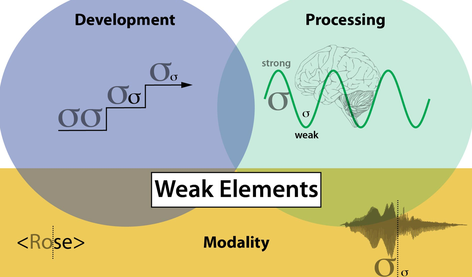RU 5757
Weak Elements in Phonology: Development, Processing, and Modality
Empirical research of the past decades has established the importance of prosody in language acquisition and processing. The distribution of prominent prosodic units, for instance, has been shown to bootstrap lexical and syntactic learning (word-stem and phrase-type identification) during the first year of life. However, the cross-linguistic comparison of prosodic systems reveals striking differences regarding weak and non-primary-stressed elements. These elements can bear secondary stress or be phonetically reduced and unstressable. It remains unclear, though, how they contribute to the overall structure of prosodic systems and their processing.
Weak elements are not per se less informative than strong ones. For instance, the weak syllables in German words like “Skizzen-Pl” (‘sketches’), “hörtet-Pst.2Pl (‘heard’), or “Vaters-Gen.M.Sg” (‘father’s’) encode grammatical features like number, tense, gender, and case.
Furthermore, different grades of weak syllables can establish different prominence relations between strong and weak elements that may affect the acquisition of prosodic structures in first and second languages. Since unstressed or reduced elements are acoustically variable and non- salient, it is likely that the acquisition and processing of such elements is demanding. Importantly, the modalities of spoken and written language need to be considered as they express weak elements differently.
Previous psycholinguistic research into prosody mainly focused on strong elements and on basic prosodic patterns like trochees or iambs, while the acquisition and processing of weak units remains little understood. The present Research Unit (RU) aims to address this understudied field of prosodic development and processing from different perspectives: How are weak elements acquired under various conditions (Altvater-Mackensen, Gabriel, Kauschke)? How do they develop historically (Lameli)? Which neuronal processes are involved in comprehending them (Scharinger)? Which roles do they play in metered verse (Blohm)? How do they influence the processing of grammatical information (U. Domahs)? How does language modality affect their acquisition and processing (Bar-Kochva, F. Domahs, Grimm)? In the first funding phase, the RU will concentrate on phenomena observable in German, which exhibits several degrees of prosodic weakness and thus differs in various ways from languages such as Italian, Turkish, and French.
The RU brings together researchers from the fields of phonetics, phonology, psycho- and neurolinguistics, writing linguistics, applied linguistics, and dialectology. The group employs a wide range of methods to examine various functions of weak elements, and to thus broaden our understanding of prosodic processing and development. The results will have implications for the evaluation of theoretical assumptions about prosodic systems, language development, and the role of modality as well as for the didactics of spoken and written language.

